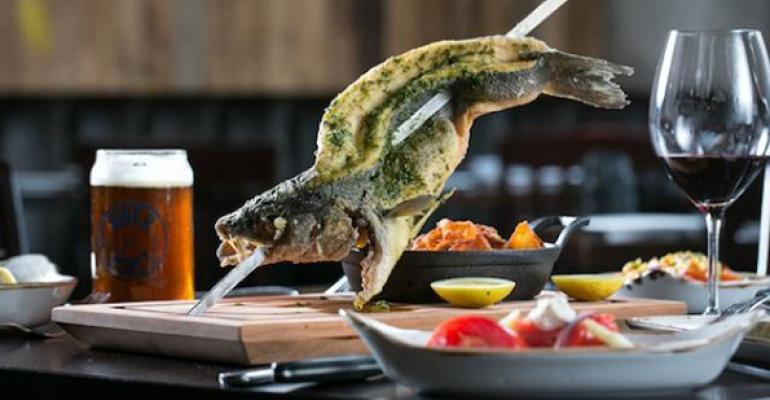This month, Nick & Stef’s Steakhouse in Los Angeles will host its first whole-fish dinner as part of the restaurant’s Whole Animal Dinner Series.
The event was inspired by the success of previous whole-animal dinners, including pig and goat.
“We realized there was a big attraction for the guest,” Nick & Stef’s chef Andreas Roller said. “There’s interest in seeing how this works, the whole process.”
For the inaugural event, Roller will bake in a wood-fired oven a salt-crusted, lemon- and herb-stuffed, 10- to 15-pound whole Atlantic loup de mer, or Mediterranean sea bass, then drizzle the finished fish with Pernod and briefly set it aflame before cutting the pottery-like crust open tableside, releasing the steamy, sweet aroma of herbs and anise, and revealing the moist and delicious meat of the fish.
“The bigger the fish, the more beautiful it comes out,” said Roller, who has served similar whole-fish preparations at other restaurants. “People like this presentation.”

While Roller said whole fish has long been a polarizing menu item — some diners love it; others say they don’t want their food looking at them — he is among a growing number of chefs serving dramatic, head-to-tail presentations to groups of diners eager to eat them.

Across the country, at Blue Duck Tavern in Washington, D.C., chef de cuisine Brad Deboy recently began serving a similar take on salt-crusted whole fish. Deboy’s version modifies the ancient technique of salt-crusting, which calls for equal parts egg whites and salt, by adding a little flour to make a dough. He stuffs the whole fish — branzino, snapper or stripped bass, depending on the season — with lemon, thyme and a bay leaf, then covers it in the dough and bakes it in a wood-burning oven. The crust is peeled back, revealing the fish tableside.
“This is my favorite way to serve and eat fish. The salt crust perfectly seasons the fish and keeps all of the moisture and juices from the fish intact,” Deboy said. “It is fun to prepare, and we present the fish in the salt crust and open it tableside, which adds to the excitement.”
Also serving a salt-crusted whole fish is Jake Addeo, executive chef of Bibiana Osteria Enoteca in Washington, D.C. For his Pesce per Due, Addeo stuffs a whole branzino with lemon, thyme, rosemary and crushed garlic, coats it in a mixture of salt, egg white, tarragon, dill and thyme, and bakes it until it gets a crust. It is filleted tableside and served with salsa verde.
At River Roast in Chicago, a concept focused on large, shareable, whole-roasted entrées, whole, fried branzino is served artfully suspended on a skewer, as if in mid jump.
“The fried fish is an impressive presentation,” said chef John Hogan. “Diners have gotten a lot more savvy. They like the excitement of seeing the whole fish. A lot will eat the crispy skin.”
To create this striking dish, Hogan debones a whole branzino, flavors it with Mediterranean herbs, sticks a skewer through it and fries it whole. The whole fish is also available roasted in a tandoori oven and served on a wooden board. No matter the preparation, Hogan says the whole fish is the second most popular dish at River Roast (whole roasted chicken is the first).
Other chefs serving up intact fish to share include Ari Weiswasser, chef and owner of Glen Ellen Star in Glen Ellen, Calif.
Weiswasser frequently offers a whole roasted fish, such as dourade stuffed with preserved Meyer lemon and fennel with romesco sauce, and presents it whole to large parties.
And when chef Adam Hegsted of The Wandering Table, a seasonal restaurant focusing on shareable items in Spokane, Wash., launches his new menu in April, it will include a whole, fried, wild Alaska rockfish, perhaps with a light sauce and julienne vegetables.
Meanwhile, Roller of Nick & Stef’s is already plotting his next whole fish dinner.
“For summer, I want to get a whole tuna,” he said.





